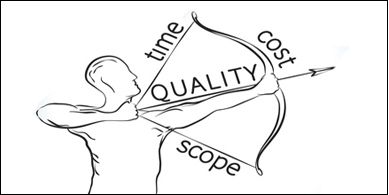
Reducing Time to Market Can’t Come at the Cost of Sustainability!
Time to market has become a key metric for measuring the successful delivery of both product/service development and internal projects. Reducing it has been the focus of process improvement initiatives and modified project lifecycle approaches and has been one of the contributing factors to the significant increase in interest in agile methods.
Intuitively, it should make sense that companies would want their projects to be completed in a shorter amount of time. Doing so would offer a number of advantages including first to market competitive advantage, being able to implement operational improvements faster or reducing business risk by complying with regulations ahead of deadlines. Beyond this, the opportunity cost of tying up skilled project resources for longer than is absolutely necessary is reduced and it should be possible to complete more value add projects over the same duration.
As with all metrics, to truly exploit the benefits of time to market, it is important to measure it in a way which will meet expected outcomes while reducing unintended consequences. The classic example of time reduction done wrong is the call center which measures and provides performance incentives to customer service agents based on how quickly they answer and close customer inquiries. Over a fairly short period of time, average call duration is likely to fall, but so will customer satisfaction.
In the context of project management, the same holds true.
For sponsors or stakeholders who might be frustrated with how long it takes project teams to start delivering scope against approved baselines, one way to address this might be to shorten the time from project kickoff to development & signoff on baselines.
Unfortunately, the unintended consequences of this might be that insufficient planning takes place or an appropriate level of stakeholder engagement is not achieved. In both cases, stakeholder dissatisfaction and increased numbers of project issues and change requests arising from missed requirements are likely to be the outcomes. You might argue that an agile project lifecycle would avoid this situation, but even with such projects, cutting corners by reducing effort spent on key architecture or design work in early sprints will result in waste in later sprints.
Sometimes the request from stakeholders is not to focus on reducing the time to complete planning, but rather to shorten overall duration before the very first deliverable is implemented. This is a reasonable expectation – projects are investments, and the longer the customer has to wait to realize the expected outcomes, the greater the likelihood that external influences will reduce benefits.
One of the more common unintended consequences of a push to reduce change delivery duration is reduced deliverable quality. As we know, increased defects results in a higher cost of quality including waste, damaged relationships with suppliers and customers, reputational damage and an increased likelihood of legal action against the company. Worse yet, such a focus can have long term behavioral impacts on the organization – once staff learn that leadership emphasis is on the speed of delivery instead of how those results were produced, it can be extremely difficult to re-instill a culture of quality.
But let’s say that deliverables are still being produced with acceptable levels of quality – should we claim mission accomplished?
In such cases, change sustainability might be the Achilles heel of the reducing time to market movement. Just because project deliverables have been implemented, doesn’t mean that desired change outcomes have been realized.
When corners are cut in analyzing change impacts on stakeholder communities, preparing these stakeholder communities for the change, progressively communicating to affected stakeholders, cultivating change champions and advocates, and using high touch approaches of overcoming short term resistance and soliciting feedback, expected behavior changes are likely to be short-lived.
This impacts not only the successful realization of a given project’s benefits but will result in a corresponding increase in the levels of change stress in affected stakeholders which in turn will cause reduced resilience and appetite for further changes.
So how can the unintended consequences resulting from a focus on reducing time to market be avoided?
The key is to design a performance evaluation model which utilizes a holistic approach to measuring project success. While time to market, or cost of delivery are important, there also needs to be post-project metrics focusing on the volume of defects, quantifying the degree of compliance with expected behaviors, measuring stakeholder satisfaction, and evaluating overall benefits realized.
You can only manage what you measure, but if you short-change what you decide to measure, you will get what you paid for!
Don’t forget to leave your comments below.
zweefparasol vierkant
… [Trackback]
[…] Read More Information here to that Topic: projecttimes.com/articles/reducing-time-to-market-can-t-come-at-the-cost-of-sustainability/ […]
buy k2 liquid on paper
… [Trackback]
[…] Find More Information here on that Topic: projecttimes.com/articles/reducing-time-to-market-can-t-come-at-the-cost-of-sustainability/ […]